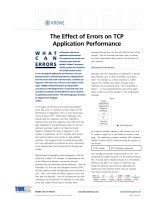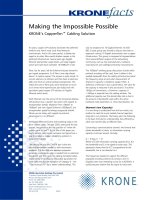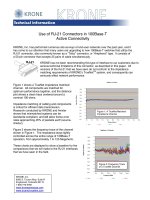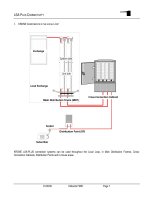Tài liệu KRONE - White paper - VoIP application in small sites doc
Bạn đang xem bản rút gọn của tài liệu. Xem và tải ngay bản đầy đủ của tài liệu tại đây (25.18 KB, 2 trang )
VOICE OVER INTERNET PROTOCOL APPLICATION IN SMALL SITES
whitepapers
1
Voice over internet protocol application in small sites
Introduction
The term VOIP appears in many different contexts. Most literally interpreted as Voice Over Internet Protocol it represents an aspect of the trend to
carry all types of communication content as IP datagrams. Nearly all businesses use data networks employing IP as the Layer 3 data encapsulation
protocol. Most businesses still employ separate networks to carry telephonic voice signals. Both systems may share the same cable infrastructure
but not the same cable, nor is there any interaction between them.
Over the last few years the benefits of intercommunication between voice and data networks have been exploited in call centres and by other
Computer Telephony Integration (CTI) applications for business such as Unified Messaging. At the same time there has been a massive growth in
world-wide IP networks, including the Internet itself. Business are now able to connect disparate sites via networks totally based on IP packet
delivery. The billing regime for IP based access networks is based on bandwidth consumed whilst the telephone network’s is a combination of
duration of call and distance to destination.
The conversion of voice into digital IP packets provides the potential for financial savings and the implementation of enhanced services.
The purpose of this report is to examine the opportunities for VOIP within the small business and small site market segments.
What
The most straightforward implementation of VOIP is two remote PC’s, equipped with either speakers and a microphone or headsets, and support for
communication via the Internet. Software handles the conversion from analogue to digital plus compression of the signal from 64Kbps down to
around 8Kbps or even less. Each PC has a connection to the Internet, usually through dial up modems. The software is free, calls can be set up to
anywhere in the world and, the only cost is the charge for time at local call rates. The shortcoming is unpredictable quality.
The above system does not allow calls to ordinary telephones. To overcome this a number of companies have been busy installing “gateway”
devices on the Internet and private wide area IP networks. These convert voice IP packets back into analogue signals for delivery to ordinary
telephones. This level of service is also enabled by a software application on the calling PC. A tariff of charges covers national and international
calls, these are usually between a quarter to one half of a telephone companies charges. Over the Internet, this method can still suffer from
unacceptable delays. On a private IP network, the perceived quality can be as good as a digital telephone service such as ISDN.
Larger companies have been adding the gateway function to their LANs to create national and global VOIP networks. The voice traffic is carried
between sites over their existing digital WAN links allowing a reduction or elimination of lines dedicated to voice calls. The WAN links may consist
of leased digital lines, always on telephone services (ISDN), or direct links to a private IP network. The gateways are added either as discrete devices
working in conjunction with existing routers and or PBXs or as routers with VOIP gateway and PBX functionality. Additional devices may be
required to perform a “gatekeeper” function that looks after address resolution. Analogue handsets are still used, wired back to the gateway. The
potential for cost savings depends on usage patterns, with private WAN IP links, international call costs can become insignificant. Even using ISDN
links, eight VOIP calls can be carried for the cost of one uncompressed digital voice call.
On fully switched LANs, IP handsets are starting to be employed. The conversion to digital signal takes place in the handset. As the handset has an
IP address, it can be automatically located on the LAN wherever it is connected. This considerably cuts down on maintenance costs by eliminating
the need to re-patch or re-programme extensions. IP handsets are commonly deployed in conjunction with integrated systems that incorporate PBX
services, CTI applications, Directory, and Unified Messaging functions.
VOIP gateways developed for smaller sites are becoming available. Examples from MultiTech and OKI were on demonstration at Networks 99 and
2000. These work in conjunction with an existing router and typically handle four analogue extensions.
Why & Where
The greatest cost savings, on the implementations so far described, are largely made on calls between a single business’s sites. Nevertheless, if the
traffic pattern is appropriate, the savings are significant enough to drive deployment.
The early VOIP systems used proprietary encoding algorithms and were thereby incompatible with other manufacturers products. Most recent
products comply with the H323 set of protocols. In theory this allows inter-operability between different products. In practice, a little more than half
of the VOIP gateways on the market co-operate successfully. In time this will be resolved because the rewards for manufacturers and vendors of
VOIP services of inter-operability are potentially enormous.
When there is sufficient installed base of Standards compliant gateway devices, VOIP calls break out of the single company domain and occur
between businesses and their suppliers and customers.
As any PC can run a software VOIP application, the only restriction to adoption by individuals is the unpredictable delivery of the Internet. This is
already being addressed on two fronts, service providers offering a higher quality of service and in the IETF IPV6 Standard, the next generation
Internet Protocol.
Unless the Telco’s respond, revenues from their most lucrative services will be transferred to the owners of global IP networks and associated
service providers. Deregulation of BT’s local loop network will give a significant boost to the service providers. Current responses are based on two
strategies: i) acquisition or merger with IP based network owners and ii) offering their own IP and VOIP services but with charges based on a
combination the bits transmitted and distance.
Who & Why
There is very little market intelligence available; the following information is from research carried out by Network Computing and CIC.
Don’t know Not applicable Never Already in place Within 1 year 1 - 2 years 2 years or more VOIP to the desk 1 11 0 5 9 39 35 VOIP to replace
PSTN 42 1 7 27 23 VOIP to replace leased lines 1 40 1 10 27 21 VOIP in small office 30 2 2 15 22 29 Conclusion
The potential market for VOIP products and services is large and growing rapidly. There is a time window for the next year or so when new players
will be able to enter the market. As time passes the market will be concentrated around fewer manufacturers and service providers.
Suppliers of hardware will find their margins under strong pressure if, as seems likely, the service providers dominate the market.
VOICE OVER INTERNET PROTOCOL APPLICATION IN SMALL SITES
whitepapers
2









